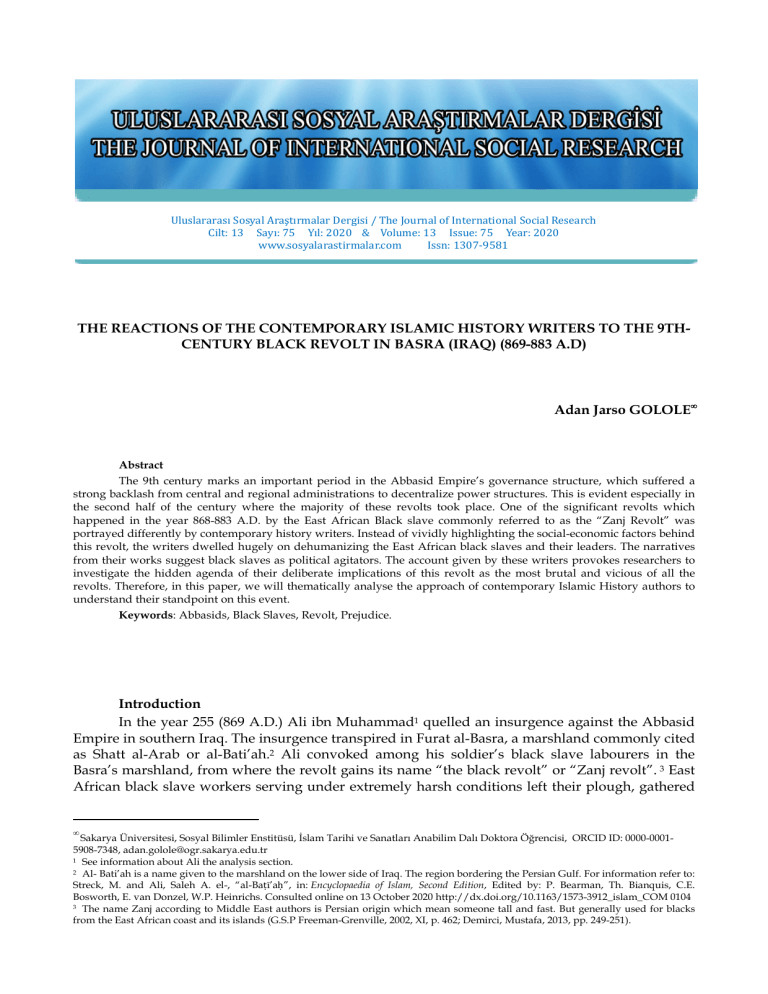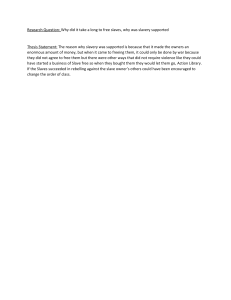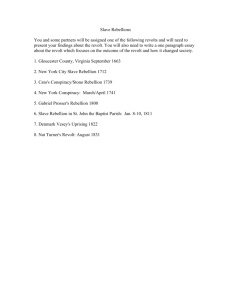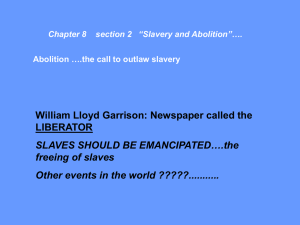
Uluslararası Sosyal Araştırmalar Dergisi / The Journal of International Social Research Cilt: 13 Sayı: 75 Yıl: 2020 & Volume: 13 Issue: 75 Year: 2020 www.sosyalarastirmalar.com Issn: 1307-9581 THE REACTIONS OF THE CONTEMPORARY ISLAMIC HISTORY WRITERS TO THE 9THCENTURY BLACK REVOLT IN BASRA (IRAQ) (869-883 A.D) Adan Jarso GOLOLE• Abstract The 9th century marks an important period in the Abbasid Empire’s governance structure, which suffered a strong backlash from central and regional administrations to decentralize power structures. This is evident especially in the second half of the century where the majority of these revolts took place. One of the significant revolts which happened in the year 868-883 A.D. by the East African Black slave commonly referred to as the “Zanj Revolt” was portrayed differently by contemporary history writers. Instead of vividly highlighting the social-economic factors behind this revolt, the writers dwelled hugely on dehumanizing the East African black slaves and their leaders. The narratives from their works suggest black slaves as political agitators. The account given by these writers provokes researchers to investigate the hidden agenda of their deliberate implications of this revolt as the most brutal and vicious of all the revolts. Therefore, in this paper, we will thematically analyse the approach of contemporary Islamic History authors to understand their standpoint on this event. Keywords: Abbasids, Black Slaves, Revolt, Prejudice. Introduction In the year 255 (869 A.D.) Ali ibn Muhammad1 quelled an insurgence against the Abbasid Empire in southern Iraq. The insurgence transpired in Furat al-Basra, a marshland commonly cited as Shatt al-Arab or al-Bati’ah.2 Ali convoked among his soldier’s black slave labourers in the Basra’s marshland, from where the revolt gains its name “the black revolt” or “Zanj revolt”. 3 East African black slave workers serving under extremely harsh conditions left their plough, gathered • Sakarya Üniversitesi, Sosyal Bilimler Enstitüsü, İslam Tarihi ve Sanatları Anabilim Dalı Doktora Öğrencisi, ORCID ID: 0000-00015908-7348, adan.golole@ogr.sakarya.edu.tr 1 See information about Ali the analysis section. 2 Al- Bati’ah is a name given to the marshland on the lower side of Iraq. The region bordering the Persian Gulf. For information refer to: Streck, M. and Ali, Saleh A. el-, “al-Baṭī’aḥ”, in: Encyclopaedia of Islam, Second Edition, Edited by: P. Bearman, Th. Bianquis, C.E. Bosworth, E. van Donzel, W.P. Heinrichs. Consulted online on 13 October 2020 http://dx.doi.org/10.1163/1573-3912_islam_COM 0104 3 The name Zanj according to Middle East authors is Persian origin which mean someone tall and fast. But generally used for blacks from the East African coast and its islands (G.S.P Freeman-Grenville, 2002, XI, p. 462; Demirci, Mustafa, 2013, pp. 249-251). Uluslararası Sosyal Araştırmalar Dergisi / The Journal of International Social Research Cilt: 13 Sayı: 75 Year: 2020 & Volume: 13 Issue: 75 Year: 2020 their machetes, and joined Ali to fight cruelty and servitude imposed on them by Abbasid tycoons supported by the government (Tabari, 36/29-33; Furlonge, 1999, 7; Reilly, 2014, 3). In a short span of fifteen years, the rioting group manage to conquer major towns in Abbasid Empire for instance, Basra, Ahvaz, Ubulla, and Ramhurmuz (Waines, 1977, p. 301). The revolt was ferociously suppressed in 883 A.D. by a massive Abbasid army co-headed by al-Muwaffak and his son Mu‘tazid. Oddly, what perplex the reader of this revolt is the race and coloured approach embraced by the contemporary history of Islam authors in their interpretation of the event. Their narration of the phenomenon vindicates the presence of ‘racialized others’. The historian’s accounts of the incident accommodate what substantiate to be deliberate racialization of the revolt. For instance, the naming of the revolt to be black revolt itself single out one race to be the rioting. However, there seems to be a notable number of black soldiers on both sides of the confrontation, as there are good number of Arab tribesmen supporting Ali’s call. My paper, therefore, examines the language and tone inured by the 9th century contemporary authors in their interpretation of this revolt. It digs out the racial phrases endorsed in the interpretation of the revolt. Consequently, answering questions like what was the viewpoint of the authors concerning the black revolt? Which connotation did they push forward in their interpretation? And what effect does their style of interpretation have on the perception of the reader toward the black people in general and the black revolt in particular? The narrative thematic analysis is adopted in the study of the resource materials. As a result, the primary focus will be the content within the works of the contemporary history of Islam authors (Butina, 2015, 193). To understand the line of inference prioritized by authors in conveying their information, the work of the 9th century Islamic history authors will be critically analysed. Particularly Tabari’s account of this revolt will take centre stage in our analysis. His work The History of Tabari’s will be our key and the most significant primary source for our study.4 In addition to Tabari, we will consider Mas’udi’s view on this revolt as well. His date of birth is supposedly towards the end of this revolt, but his interpretations of this revolt are very important for our study. His blunt statement against black people and black revolt allow us to understand his partiality and the usual social stigma around blacks and black slaves. The fact that Mas’udi, in the year 917 A.D. went for an exploration tour as far as the East African coast makes his books even a more significant resource for our paper. Other than these two contemporary historians lengthy recounts, we will also refer to materials of other scholars who despite not expressively narrating the revolt shared something about black revolt e.g. Hilal al-Sabi’s, Maqdisi, Ya‘qubi, Baladhuri, Jahiz etc. works. Additionally, the works of some recent researchers too were probed to understand their discource on the topic. Notably the work of Mustafa Demirci who attest that Mas’udi was keen to render black slave soldiers as Kharijis was scrutinized. His analysis gives hints that contemporary scholars have partisan issues in their interpretation (Demirci, 2017, 26). More so the work of many other scholars like Benard Lewis, Southgate, Nöldöke etc. were approached as well. Although analysing and interpreting such a crucial topic may bear some subjectivity, we will be careful not to lose the nuance. Analysis of the Contemporary Author’s Interpretation of the Black Revolt and Findings Despite the black revolt coinciding with several other revolts in the 9th century Abbasids, the black revolt was portrayed by the contemporary authors as the most vicious and villainous revolt. Tabari and Mas’udi for instance in their work seem to be very much preoccupied and engrossed with this revolt. Tabari gave a detailed narration of this revolt. Their narration of the revolt seems to deliberately overlook the suffering of the East African black slaves in the hand of 4 Tabari reveals that he was in Baghdad when this revolt took place. Hence becoming a firsthand reporter of the revolt. - 269 - Uluslararası Sosyal Araştırmalar Dergisi / The Journal of International Social Research Cilt: 13 Sayı: 75 Year: 2020 & Volume: 13 Issue: 75 Year: 2020 their masters. Instead of contemporary authors explaining the social and economic ordeal facing the black community in the Basra’s marshland, they engaged the readers with criticism of black slaves who are victims of social discrimination and torture from their masters. Their languages and connotations remind readers of the racial problems and colour-consciousness of middle-east societies. According to black colour symbolize evil, wickedness and ugly among other dehumanizing traits. The convictions made by authors can be analysed as follow: The Black Slave’s leader Ali b. Mohammad is Depicted as Ignoble Both Tabari and Mas’udi put doubt on the origin of the lineage of Ali ibn Muhammad. Tabari further reveals that Ali’s paternal grandmother is a concubine from Sind (Tabari, 1989, 38/30) and that he is not a noble leader as he claims. Although what Tabari says about Ali may hold some water to a certain degree the points driven forward against Ali’s paternity implicates the author's intention to put him in a disgraceful position. The author knowing the fact that the Medieval Middle East society judge individuals based on their genealogy (that belonging to certain genealogy was considered honourable for instance belonging to the Hashimite Arab clan or Prophet’s lineage was considered special) he put doubt in the origin of the black revolt leader Ali ibn Muhammad. However, the author's approach to Ali’s family background raised an eyebrow. Because by questioning the lineage of Ali the authors were ostensibly probing the ambiguity in his genealogy, but the reality is that, they are shaping the perception of their readers on the leader. Tabari is seen to go the extra mile and mention that Ali’s paternal grandmother is from Sind, thus automatically specifying Ali of having a blood relation with black people or a community considered black by Middle Eastern society (Tabari, 36/30). Because during this period Sind’s are considered one of the black nations. For example, Mas’udi in his book ‘Meadows of Gold and Mines of Gems’ while narrating about Sind people and their origins declares that they are part of the black nation. He argues that the black community including Sind’s are less intelligent compared to other races. However, Sinds (Hindu) are recognizably different from the other black nations in terms of intellect, philosophy, governance, etc (Mas’udi, 1841, pp. 177-178). Regardless of Mas’udi’s negative racial statement against blacks he clearly showed that Sinds are classified to be one of the Black origins during his period.5 The issues of the medieval Middle East societies attributing one anothers geonology to the black people as form of disgration is a common factor. Their works and materials have a lot of examples, al-Mubarrad (d. 898 A.D.) a biographer and philologist shares a poem of two poet Ahtal and Kathir accusing one another of having pedigree stretching to black people which was deemed as an abject shame (Mubarrad, 1997, 1/100). So Tabari’s description of Ali’s paternal relation with Sind also signifies the author's effort to put Ali in the same category as his black soldiers. Eventually declaring him to be a black leader heading a black revolt, a race group socially disparaged in the medieval Middle East society. Jahiz (d. 869 A.D.) explain that black people were perceived as inferior group of humankind (Jahiz, 1996, p. 314). Ibn al-Qutayba (d. 890 A.D.) declare that they are considered inferior, and with unsought physical structured because they are overcooked in the wombs of their mothers due extreme hot weather condition in their region (Ibn al-Qutayba, n.d, p. 79). Though authors argument that Ali’s claim of having the same bloodline as the prophet is baseless may concur with reality, their wholesome denial of his pedigree is uncommon6 (Tabari, Bernard Lewis also confirms that Middle East societies include Indians and Copts to be part of black society (Lewis, 1990, p. 70). Concerning Ali’s relation with Prophet Muhammad, there is account in al-Safadi’s (d. 764/1363) book al-Wafi bil-Wafayat which is shared by Popoviç whereby Ali’s mother narrate that her husband and Ali’s father is adopted son. His original family is stated to have bloodline with Ali b. Abi Talib cousin of Prophet Muhammad and son-in-Law. Al-Safadi lived almost five centuries after the black revolt but if his accounts were to be taken into consideration Ali’s bloodline seem to concur with Prophet Muhammad’s. see Alexandre P. (1999). The Revolt of African Slaves in Iraq in the 3rd/9th Century. 5 6 - 270 - Uluslararası Sosyal Araştırmalar Dergisi / The Journal of International Social Research Cilt: 13 Sayı: 75 Year: 2020 & Volume: 13 Issue: 75 Year: 2020 37/30-31; Nöldeke, 1892, 146-147; Alexandre, 1999, 34; Furlonge, 1999, 8). A historian like Miskavayh (d. 421) who lived in Ray, the birthplace of Ali b. Muhammad clearly states that Ali’s paternity is authentic and has nothing to be questioned (Miskavayh, 1997, 4/397). Miskavayh affirmation of the authenticity of Ali’s lineage at least signifies that the author's disapproval of his origin was suspicious. It implicates that authors chose to put forward in their interpretation the genealogy card of the black revolt leader Ali b. Muhammad to undermine his personality and leadership possibility. The same scenario is exemplified to undercut the performance of his rioting soldiers. Even though his armies consist of blacks and non-black soldiers the revolt was declared the black revolt. A deliberate move by authors to utilize race factor against this revolt. Other than singling out one party and condemning them for all the vice in the revolt, the race factor was much prevalently employed in the entire interpretation of the revolt in the authors’ works. Black Slaves were Illustrated as Errant and Elusive What is evident from the author’s interpretation of this event is their resentful implications that black slaves are dishonest and elusive. Their works portray a societal understanding, whereby the human nature of black slaves is replaced with fugitive featherhead creatures, and that these feebleminded creatures whenever they get the opportunity they can run away from their masters. For instance, Tabari while narrating some occurrence at the beginning of this revolt is seen to shares an anecdote expressing a dialogue between slave masters and the leader of Ali b. Muhammad. In the dialogue, the slave masters warned the black slave’s leader Ali concerning black slaves' suspicious and habitual runaways tendency. More so, they advised him to handover slaves to their masters and go for a compensation of 5 dinars a month for every black slave. Because the masters can accordingly handle black slaves in the marshlands. Otherwise, due to the fugitive nature of the black slaves, Ali will stand to lose both the slaves and the money. Ali was not convinced by their condemnation, he was rather seen to oppose the masters and stand by the slaves (Tabari, 1989, 36/36-37). In this anecdote, the black slaves are condemned to be runaways but in the 15 years of war and death, the East African Black slaves stood by their leader. More so the black slave loyalty to their masters is evident in many works. For instance, Bacharach while comparing the loyalty of slave soldiers describes that black slave soldiers are more loyal to their political masters than the other troops in the medieval Middle East history- History of Islam- for that matter (Bacharach, 1981, 471). This example once again clearly shows that black slaves never had any loyalty problems, and they were not elusive as depicted by Tabari in his dialogue. On the contrary, they were always ready to pay a heavy price in fighting for their liberty. Black Slaves are Shown as Destructive In Tabari’s account of the revolt, black slaves appear to be devastating and damaging to the people’s land, homes, and properties. They burned down villages, houses, farms, and palm trees. In most of the paragraphs where the author narrates about black soldiers capturing towns and villages, he often ends it with blacks burning, torching, raze, set on fire, etc. Though most of the revolts during this time were equally destructive and ruinous, Tabari seems to be obsessed with showing black slaves’ soldiers actions as devastating. He continually accused them of burning downtowns, plundering villages, slaughtering animals, perpetuating outrage, and atrocities. A teakwood city of al-Ubullah, al-Nu’maniyyah, etc. which went on fire in the confrontation is used by the authors as an example of black slave soldier’s distractive behaviour (Tabari, 36/58, 204). Other than towns, cities, and villages took under control by force the author claims black slave soldiers equally torched, pillaged, overwhelmed cities and villages they enter without any form of resistance e.g. city of Jubba and its environs (Tabari, 36/111-112). In al-Muhallabiyyah he shares narration whereby a village left by dwellers empty is set on fire by a black soldier. In - 271 - Uluslararası Sosyal Araştırmalar Dergisi / The Journal of International Social Research Cilt: 13 Sayı: 75 Year: 2020 & Volume: 13 Issue: 75 Year: 2020 Madiyan canal dates plantations are burned (Tabari, 1989, 36/50-51). In the village of Dubba7 Ali’s black soldier slaughtered sheep and cattle of the villagers. Black soldiers’ activity of torching people’s settlement may be destructive as Tabari claims but considering many other revolts continuing in the Abbasid empire at that time e.g. Tulunids revolt (868-905) in Egypt and Syria, Tahirids (821-873 A.D.) in Khorasan, Samanids (819-1005) in Persian, Saffarids (861-1003 A.D.) in Sadjistan, etc. and the destruction done to Abbasid cities and villages, singling out black revolt as most destructive is an overstatement of what transpired. More so, the same destruction is also done by central authority soldiers when they enter black slaves’ towns and villages. Especially, after central government authority gathered up its strength and started winning they seen burning and setting on fire several black slave towns and villages e.g. in al-Sinniyah, Dayr al-Ummal, etc. (Tabari, 37/20-21). In Muhktara8 when central authority soldiers are trying to conquer the city they torched houses, markets, and destroyed structures e.g. in the year 268/883 and 269/884 central authority soldiers repeatedly break into Muhktara set on fire structures, demolished buildings, looted houses, and made many killings (Tabari, 37/62, 67). Structural, physical, and emotional destruction done to the East Africa Black slaves, their sufferings before the revolt, the horrendous torture they experienced during the governments' forceful purge of Black revolt, and the racial cleansing that followed in the aftermath of the revolt seems to take very little space in the books of these authors. Furthermore, the rhetoric’s of portraying blacks as destructive is not exclusive only to these authors, in contrary it has been conventional practice of medieval Middle East scholars to vindicate blacks as source of destruction. The traditionalist (Hadith scholar) Abd al-Razzaq al-San’ani9 in his book al-Musannaf shares a narration stating, “there is nothing good from black man” (Abd al-Razzaq, 2015, 4/236). Black Soldiers are Represented to Target Women Both Tabari and Mas’udi brought out the issue of black soldiers targeting women in their works. Tabari narrates Ali and his Black soldiers after plundering the villages of al-Qadisiyyah and al-Shifiya took with them women and slaves (Tabari, 36/48). In the year 269/884 while narrating the destruction caused by central authorities’ soldiers to the blacks soldiers’ capital Muhktara Tabari conclude by saying that many Muslim women were saved from the black soldiers (Tabari, 37/103). A statement that is aimed at driving home perpetual black soldiers and black people hunger for women. At the battle Suq al-Khamis the central authority army leader Abu Ahmad (alMuwaffak) is narrated to save 5000 Muslim women including some Zanj women and send them to Wasit. Later advised them to be sent to their families (Tabari, 37/26). But the fact that central authority soldiers also abducted some Zanj women again proves that kidnapping of women was common practice in both warring parties and not a solemn habit of black slave soldiers. Conversely, some accounts reveal that black slave soldiers were not a threat to women. For example, women in black slave soldiers camp were seen fighting their enemy shoulder to shoulder with their soldiers (Tabari, 37/46). The perception that blacks and black slaves have uncontrolled passion for women is a false perception prevalent in medieval Middle East society. Many poems and legendary writings of this society seriously advocating for these understandings. Al-Isfahani for instance in his Kitab al-Tarih Isbahan shares a statement in which he declares that “the worst type of slaves are black slaves because when their stomach is full they fornicate when they are hungry they steal” (Isfahani, A. (n.d). 58). Bernard Lewis state that medieval Middle East societies presume Blacks have a serious deprived passion for women (Lewis, 1990, 99). As a result of their force perception most of the Dubba is one of the subdistricts of Basra. It has many canals. Tabari, 36/57. Muhktara is the major and the capital city of revolting group. 9 Motzki, Harald, “ʿAbd al-Razzāq al-Ṣanʿānī”, in: Encyclopaedia of Islam, THREE, Edited by: Kate Fleet, Gudrun Krämer, Denis Matringe, John Nawas, Everett Rowson. Consulted online on 11 November 2020 <http://dx.doi.org/10.1163/1573-3912_ei3_SIM_0083> 7 8 - 272 - Uluslararası Sosyal Araştırmalar Dergisi / The Journal of International Social Research Cilt: 13 Sayı: 75 Year: 2020 & Volume: 13 Issue: 75 Year: 2020 male black slaves especially those serving as domestic workers were castrated an activity that complicated their lives by having almost 90 per cent of the slaves dead. Black Slaves were Blamed to be Ruthless Killers Black slaves’ soldiers were implicated as killing people indiscriminately. Mas’udi characterized them as beheading women, children, and the elderly who were not supposed to be killed in any act of war (Mas’udi, 2005, 4/156). Tabari narrated that they killed a mass number of people in Basra, Ubbullah Ahwaz, Dubaryan, river Bayan, etc. he shares several accounts where the black soldiers chopped of heads, arms, legs, etc. of central authority soldiers. For instance, a bloody encounter of central authority soldiers and Ali’s soldiers in the Dubaryan and Bayan region where black slave soldiers bought one thousand heads of central authority soldiers killed is narrated with exaggerated perplexity (Tabari, 1989, 36/54-55). In the conquest of Basra Ali is accused of ordering to mutilate the dead bodies of central authority soldiers. He ordered the heads of central authority soldiers chopped off, loaded into a boat, and sent it to the city (Tabari, 36, 66). Similarly, central government soldiers are also seen to behead black slaves’ soldiers when they were attacking their capital Mukhtara. They loaded the heads of black soldiers on their ships and carried them to their camps. The heads of slain black slave soldiers were hanged and there were crucified (Tabari, 37/53). Black Slaves were Illustrated as Cannibals The authors are their narration repeatedly raised the issue of black slaves feasting on human flesh. Tabari shares an account where black slaves soldiers killing central government soldiers and fighting to apportion the flesh of the armies (Tabari, 36/144). Although remorseless killing was done by the government army and the black slaves, Tabari’s narration of the blacks fighting to apportion the flesh of a dead army, depicted his position to support the false belief held by the Middle East society possess against the black people. The belief that black people are cannibals is repeatedly brought forward in the works of contemporaries. For instance, in the year 269/884 Tabari narrates that Ali b. Muhammad and his black soldiers were taken under blockade in their camp for several months until they started hunting one another for food. He claims the stronger black soldiers hunted their weak colleagues, women, and children for the meal. He further states that dead bodies were removed from graves and consumed. Though Tabari narrations of people eating their dead children and relatives during the serious famine and hunger strike are common, this one was particularly meant to instigate in the mind of readers the black soldiers' cannibalistic nature (Tabari, 37/101-102). Hilal as-Sabi, in his lengthy description of Caliph Mu‘tazid Army state that the black soldiers are kept away from other soldiers because they are eaters of human flesh (Sabi, 1904, 16). Al-Hamdani, declares blacks are aggressive and their behaviour resembles wild animals than being human, they have no mercy for themselves and others (al-Hamadani, 1884, 22). Makdisi too in his work Bad’u wa al-Tarikh claims that blacks in Africa don’t have food to eat, they hunt one another for food (Makdisi, 1/207). A factor which signify that “black is dangerous” perception and the discriminative language continued even after the revolt. Black East African Slaves are Presumed to be Blasphemous and Profane Even though slaves in the Middle East society were believers of religions of their masters, the East African slaves were denounced as disrespectful and irreligious. Tabari stated that the blacks killed people who are shouting and declaring their devotion to God, burned down the congregational mosque (Tabari, 36/132). On the contrary, when the East African black slave’s mosque was destroyed by soldiers affiliated to the central authority, Tabari declared that the soldiers went into the structure which abominable call its mosque and destroyed (Tabari, 37/87). It - 273 - Uluslararası Sosyal Araştırmalar Dergisi / The Journal of International Social Research Cilt: 13 Sayı: 75 Year: 2020 & Volume: 13 Issue: 75 Year: 2020 is clear from the author's declaration of the black mosque as a mere structure that he was either not convinced with the true beliefs of the black slaves or he wanted to conform to the common social understanding that all blacks were infidels. But in contrast with general understanding, these East African Black slaves were mostly Muslim. This was evident from their building of mosque and utterances during wars, whereby they are calling out “God is great” (Allahu Akbar) which was a common practice among the Muslims during wars. Conclusion In conclusion, it is clear from the above analysis that although the 9th Century East African Black revolt in Basra (Iraq) is a vital social revolt in medieval Middle East history, the interpretation of the contemporaries is marred with traditional Middle East societies prejudice and stereotyped against black people. Contemporary authors made extraordinary efforts collecting narrative to convey the history to the later generations, but their interpretation of the event invokes negative assumptions against the black people. They seem to suffer from the same social problem obscuring their societies from fairly treating black slaves. Their work is marred with connotations approving the false belief of medieval Middle East societies against the blacks and black slaves. The contemporary author's narrative was affirming the conventional understanding of the blacks by Middle East societies of Arabs, Persian, etc. According to them, blacks and black slaves were seen as uncivilized, primitive, wicked, intellectually deficient, cannibals, monsters, irreligious, infidel, devil, etc. (Southgate, 13-20; Lewis, 99). The narrative of these historians proves right the image or a character of a black man in the Middle Eastern poems, proverbs, legends, etc. that spread outrageous negativity toward blacks and black slaves. Bernard Lewis book Race and slavery in the Middle East and Minoo Southgates article The Negative Images of Blacks in some Medieval Iranian writings give detailed information of both Arabs and Persian negative perception of black people. The author's interpretation seems to be either influenced by the social pressure or willing to put racial problems forward other than the social-economic and cultural rejection leading to the revolt. They blame black East African slaves for the havoc caused by this revolt. A factor which proves that the historical interpretation of the 9th century black revolt, especially materials found in the work of contemporary historians are tainted with serious prejudice over the black people. REFERENCES Abd al-Razzaq al-San’ani. (2015). al-Musanaf. Cairo. Dar al-Tesil. Alexandre, P. (1999). The Revolt of African Slaves in Iraq in the 3rd/9th Century. Princeton, United State: Markus Wiener Publishers. Al-Hamadani, H. (1884). Sifatu Jazeeratu’l-Arab. Leiden: Brill. Bacharach, J. (1981). African Military Slaves in the Medieval Middle East. The cases of Iraq (869-955) and Egypt (868-1171). Cambridge University Press, 13(4), 471–495. Bernard, L. (1993). The Arab in History. New York, United State: Oxford University Press. Bosworth, C., Marín, M. & Smith, G. (?). Ṭāhirids. Encyclopaedia of Islam, Second Edition, Edited by P. Bearman, Th. Bianquis, C.E. Bosworth, E. van Donzel, W.P. Heinrichs. http://dx.doi.org/10.1163/1573-3912_islam_COM_1152 Butina, M. (2015). A Narrative Approach to Qualitative Inquiry. Clinical Laboratory Science, 28 (3), 190-196. Demirci, M. (2013). Zenc. TDV İslâm Ansiklopedisi. https://islamansiklopedisi.org.tr/zenc Freeman-Grenville (2002). The Zandj. In Encyclopaedia of Islam, Vol. XI. Brill. Freeman-Grenville & Popovic (?). A. al-Zandj. Encyclopaedia of Islam, Second Edition, Edited by P. Bearman, Th. Bianquis, C.E. Bosworth, E. van Donzel, W.P. Heinrichs. http://dx.doi.org/10.1163/15733912_islam_COM_1379 Furlonge, D. (1999). Revisiting the Zanj and Re-visioning Revolt: Complexities of the Zanj Conflict (868-883 A.D). Association for the Study of African American Life and History, 62(4), 7–14. İbn al-Qutayba, Abdullah b. Muslim b. Qutayba. Uyunu’l Ahbar. Beirut, Lebanon. Daru’l Kutubu’l İlmiyye. Jahiz, Abu Uthman Amr b. Bahr b. Mahbub al-Kinani (1996). al-Hayavan. Beirut: Daru al-Jil. Lewis, B. (?). ʿAbbāsids. in Encyclopaedia of Islam, Second Edition, Edited by P. Bearman, Th. Bianquis, C.E. Bosworth, E. Van Donzel, W.P. Heinrichs, http://dx.doi.org/10.1163/1573-3912_islam_COM_0002 - 274 - Uluslararası Sosyal Araştırmalar Dergisi / The Journal of International Social Research Cilt: 13 Sayı: 75 Year: 2020 & Volume: 13 Issue: 75 Year: 2020 Lewis, B. (1990). Race and Slavery in the Middle East. A Historical Enquiry, Oxford University Press. Makdisi. (n.d). Bad’u wa al-Tarih. Mas’udi, A. (2005). Muruc al-Zahab ve Mâadini al-Jawhar. Beirut, Lebanon: Maktaba El-Asriyy. Mas’udi. (1841). Meadows of Gold and Mines of Gems. (Vol. 01). Harrison and Co. Printers. Miskaveyh, A. (1997). Tajarib al-Umam. Dar Saruş lil-Taba ve’l-Naşr. Motzki, H. ʿAbd al-Razzāq al-Ṣanʿānī. In Encyclopaedia of Islam, THREE, Edited by: Kate Fleet, Gudrun Krämer, Denis Matringe, John Nawas, Everett Rowson. Consulted online on 11 November 2020 <http://dx.doi.org/10.1163/1573-3912_ei3_SIM_0083> Mubarrad, M. (1997). al-Kamil fi’l-Lüga ve’l-Edeb. nsr Muhammad Ebu’l-Fadl Ibrahim, Cairo: Daru’l-Fikri’l-Arabi. Nöldeke, T. (1892). Sketches from Eastern Hıstory. A Servile War in the East. London: Adams & Charles Black. Reilly, B. (2014). Mutawalladean and Malaria: African Slavery in Arabian Wadis. Oxford University Press, 47(4), 878–896. Sabi, H. (1904). Tuhfatu’l Umeraa fi’l Tarihi’l Vuzaraa. Maktabatı’l ayan. Southgate, M. (1984). The Negative Images of Blacks in some Medieval Iranian Writing. Taylor & Francis, Ltd. on behalf of International Society of Iranian Studies, 17 (1), 3–36. Streck, M. and Ali, Saleh A. al-Baṭī’aḥ. in: Encyclopaedia of Islam, Second Edition, Edited by: P. Bearman, Th. Bianquis, C.E. Bosworth, E. van Donzel, W.P. Heinrichs. Consulted online on 13 October 2020 http://dx.doi.org/10.1163/15733912_islam_COM 0104 Tenûhî, A. (n.d.). Nişvaru’l Muhadara ve Ahbaru’l Mudakara. Dar Sâdr. Taberi, M. (1989). The History of al-Tabari (Ta’rikh al-rusul wa’l-muluk). Translated by Franz, R. State University of New York Press. Waines, D. (1973). Caliph and Amir. A study of the Socio-Economic Background of Medieval Political Power. Mcgill University. Waines, D. (1977). The Third Century Internal Crisis of The Abbasids. Journal of the Economic and Social History of the Orient, 20(3), 282-306. Willie F. & Hunt D. (2005). Encyclopedia of African History and Culture. in Encyclopedia of African History and Culture, Vol. 1, The Learning Source. - 275 -



